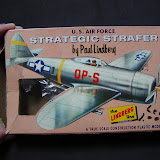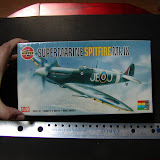
Imagine it's the early 1960's. Plastic model building is really starting to take off, especially here in the States. All variety of plastic models are available; ships, cars, space, aircraft. The latter, model airplanes, were usually the most inexpensive of the lot, and many model builders got their start with them.
The US, though, was slow to jump on the scale bandwagon. While model cars were being turned out in scales that were either 1/24 or 1/25, it took longer for model companies to care about them. Well, perhaps that isn't quite true; Monogram and Hawk were certainly turning out kits in 1/72 and 1/48, especially the larger of those two scales, and Lindberg was producing a few kits in 1/64 as well.
It was the plastic powerhouse Revell of Venice, California that lagged a little behind. Keep in mind that by the early 1960's, both Frog and Airfix already had extensive lines in 1/72. Most of Revell's kits were "box-scale", designed to fit a box, not a regular scale. You had aircraft as large as 1/45 sharing a common box size that also held models down to 1/180. The scales were all over the place.
When Revell decided to go to a true scale, they chose 1/72 for their aircraft kits. By the mid-1960's, they had a large number of World War II fighters and bombers, behind only Airfix in their offerings.
But these weren't Airfix quality.
While they were fairly good at capturing the appearance of many of the aircraft, most of the kits lacked good detail. Some parts were just wrong (quite often the landing gear), while others were stretched (their Spitfire Mk. II's fuselage) or squashed (canopies on the Spitfire, P-47D and F4U-1D). Some kits were surprisingly good (their Wildcat and Hurricane), others not. The kits also felt thin and somewhat flimsy. This is something I always felt about Revell's kits from this era; the plastic parts always felt thin. As the dies aged, this thinness presented further problems, namely flash and quite often short-shot parts.
For us here in the States, though, the presence of scale kits meant that we could now build accurate collections. Want to see how small a Bf-109E was next to a B-17F? All you needed was the money for the kits. The American molded Revell kits were inexpensive to boot, always lower in cost than imports, so you could build a collection relatively inexpensively.
The photo I've posted is of three of the fighter aircraft in various boxing, from 1963 (the P-47D), 1974 (the F4U-1) to 1988 (the Spitfire). For many of us, this was the only way to have some of these models in our collection, so we learned to either live with the shortcomings or honed skills to correct them.
For the average builder today, these kits have long been supplanted; there is not a kit from this series that hasn't been replaced. Those of us who love nostalgia, however, look upon them with most assuredly rose coloured glasses.









